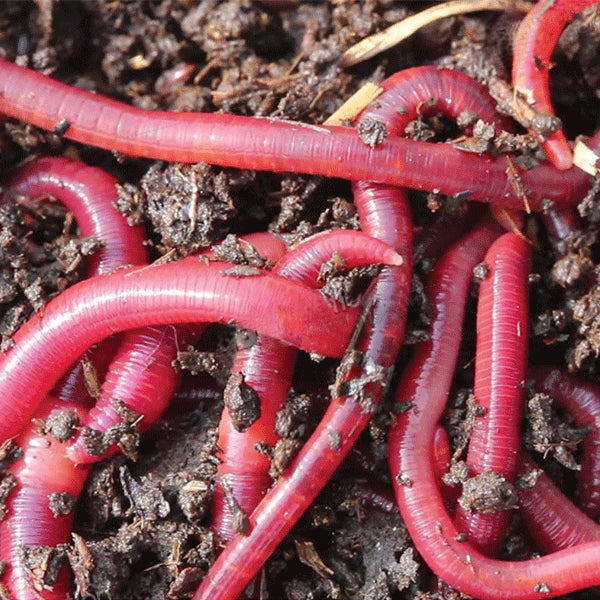Every Little Thing You Required to Learn About Red Wigglers for Composting
Red wigglers, or Eisenia fetida, play a critical role in the world of composting, changing organic waste right into useful soil amendments. The procedure of establishing up a worm bin and keeping it can present difficulties.
What Are Red Wigglers?

Native to The United States and copyright, red wigglers are surface-dwelling microorganisms that favor wet, warm habitats rich in decomposing natural issue. Their diet plan consists mainly of decomposing plant product, food scraps, and other organic debris, which they consume and damage down effectively. As they digest this material, they generate nutrient-rich spreadings that improve soil fertility.
Red wigglers are hermaphroditic, possessing both male and women reproductive organs, and can replicate rapidly under optimum conditions. This capacity makes them an optimal choice for composting systems, as their populace can increase quickly. Their resilience and versatility to numerous atmospheres better solidify their relevance in sustainable waste administration practices. Generally, red wigglers are essential contributors to the procedure of reusing organic waste right into beneficial compost.
Advantages of Using Red Wigglers
Utilizing red wigglers in composting systems uses countless advantages that enhance both the performance of waste monitoring and the quality of the resulting compost. These worms, clinically referred to as Eisenia fetida, are specifically effective at breaking down organic issue, transforming cooking area scraps and backyard waste into nutrient-rich compost at an accelerated rate.
One of the main advantages of making use of red wigglers is their capacity to eat big quantities of organic material, commonly refining their weight in food waste daily. This high intake price brings about much faster decomposition and reduces the volume of waste sent to landfills. The spreadings generated by red wigglers are abundant in necessary nutrients, helpful microbes, and enzymes, making them an exceptional plant food for gardens and plants.
Additionally, red wigglers thrive in a selection of settings, making them versatile for both indoor and outdoor composting systems - red wigglers. Their presence in a garden compost container assists to aerate the product, protecting against smells and promoting a healthy and balanced composting procedure. Generally, utilizing red wigglers not only adds to efficient waste management yet likewise supports sustainable horticulture methods through the manufacturing of high-grade garden compost
Establishing Your Worm Container
To successfully set up a worm bin, it is necessary to pick an appropriate container that meets the requirements of red wigglers while supplying a favorable setting for composting. An ideal container can be made from plastic, timber, or steel, with a capacity of at least 1 square foot for every pound of worms.
Guarantee the container has sufficient drain holes to stop excess dampness, as red wigglers prosper in a wet, yet not water logged, setting. red wigglers. The container must likewise be aerated to supply enough air flow, stopping anaerobic conditions that might harm the worms
An ideal location for the worm container is a trendy, dark location, devoid of straight sunlight and extreme temperatures, as red wigglers favor a temperature level variety of 55 to 77 degrees Fahrenheit.
Before presenting the worms, prepare bed linens products such as shredded newspaper, cardboard, or coconut coir, which will give both environment and food. Moisten the bedding gently to develop a welcoming environment for the worms. Think about placing a cover on the bin to keep moisture and decrease parasites, while guaranteeing it can be easily gotten rid of for maintenance.
Feeding and Care Standards
Feeding red wigglers is an important aspect of keeping a healthy composting system. These worms grow on a diverse diet regimen, mostly composed of natural materials such as fruit and veggie scraps, coffee grounds, and smashed eggshells. It is vital to avoid feeding them meat, dairy products, and oily foods, as these can create undesirable smells and draw in insects.
When presenting food to your worm bin, cut or read review shred materials right into smaller pieces to promote quicker decay. Start with percentages to determine the worms' usage rate, progressively increasing the amount as they adjust. It is a good idea to alternative feeding locations within the container to urge complete blending and aeration of the garden compost.

Troubleshooting Common Issues
Keeping a growing worm composting system can occasionally offer difficulties that require attention and troubleshooting. Usual concerns include an unpleasant smell, which usually suggests overfeeding or the existence of anaerobic conditions. To treat this, minimize the quantity of food added and make certain appropriate aeration by blending the bed linen material.
An additional regular problem is the retreat of worms from the container. This can occur as a result of extreme moisture or improper ecological conditions. Consistently inspect the moisture degrees, aiming for a wet however not soggy uniformity, and maintain optimum temperatures in between 60-80 ° F(15-27 ° C )to create a comfy habitat for your red wigglers.
Parasites, such as fruit flies, can likewise attack worm bins. red wigglers. To battle this, cover food scraps with a layer of bed linen or shredded paper to deter flies from laying eggs. Furthermore, ensure that any kind of food added is fresh and complimentary from mold, which can draw in undesirable insects
Last but not least, if your worms seem non-active, inspect for stress and anxiety elements such as temperature level fluctuations or insufficient moisture. Dealing with these usual issues will certainly help preserve a healthy and balanced and productive worm composting system.
Verdict
In summary, red wigglers, or Eisenia fetida, play an essential role in sustainable waste monitoring through vermicomposting. Their capability to successfully convert organic waste right into nutrient-dense spreadings enhances soil wellness and promotes plant growth. Appropriate arrangement and upkeep of a worm bin, together with adherence to feeding standards, ensure a flourishing ecological community that minimizes land fill payments. Addressing common problems immediately further supports the efficiency of this environmental technique, adding to ecological sustainability and farming productivity.
Comments on “Garden-helper red wigglers: Best methods to keep them”